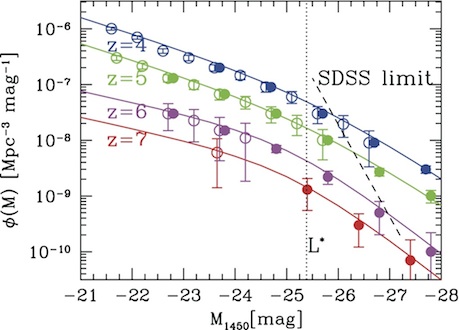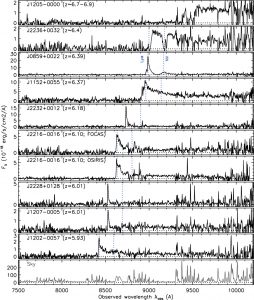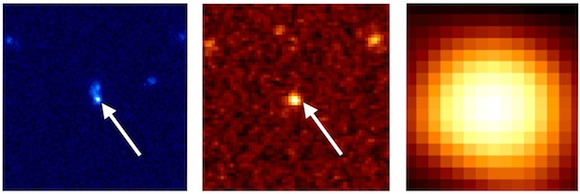Supermassive Black Holes and AGNs
Our WG aims to understand the cosmological evolution of supermassive black holes (SMBHs) and the physics behind the coevolution of SMBHs and galaxies, through extensive searches for various populations of active galactic nuclei (AGNs) at various redshifts. Thanks to the wide survey area (~1400 deg2) and superb sensitivity (i~26) in the HSC-Wide layer, we will discover quasars beyond z=7 and obtain the quasar luminosity function over a wide luminosity range at various redshifts (Fig.1). Our follow-up spectroscopic observations of the candidates selected from the early data successfully confirms new quasars at z=6-7 (Fig. 2). A unique aspect of our HSC survey is that the HSC-Deep layer (~28 deg2) will be monitored over ~5 years, enabling us to detect low-luminosity AGNs via their variability whose brightness is much fainter than their host galaxies (Fig.3), allowing us to explore the coevolution of SMBH and a galaxies via their variability. By combining the deep and wide HSC data and wide-field survey data at various other wavelengths (e.g., X-ray, infrared, and radio), we will be able to investigate various interesting AGN populations that cannot be identified with optical data alone (Fig.4).

Fig.1. Expected quasar LF over z~4-7 obtained with the full HSC survey. The filled and open circles correspond to the Wide and Deep layers, respectively. Our survey will determine the quasar number density at much fainter magnitudes than the SDSS limit (dashed line), well below the characteristic luminosity (L*; dotted line).

Fig. 2. We are identifying a large number of quasars at high redshifts (z>6). The figure from Matsuoka et al. (arXiv: 1603.02281) shows the spectra taken with the Subaru Telescope and Gran Telescopio Canarias (GTC). These objects are ~2 magnitudes fainter than those explored in the previous wide-field surveys.

Fig.3. Example of a variability-selected, broad-line AGN at z=2.150 (Morokuma et al. 2008). Left and middle panels show optical images taken at different epochs, and right panel shows the residual of the two images. The box size is 20 arcsec.

Fig. 4. Example of dust-obscured galaxies (DOGs) with an obscured AGN, identified by combining the HSC (left), VIKING (middle), and WISE (right) images (Toba et al. 2015). The box size is 20 arcsec. DOGs hosting obscured AGNs are likely the key population to understanding the co-evolution of SMBHs and galaxies. Since these objects are very faint in the optical and are rare, previous shallow surveys have missed them. The HSC data combined with public data from VISTA-VIKING and WISE allows us to discover these dusty objects and study their statistical properties.
